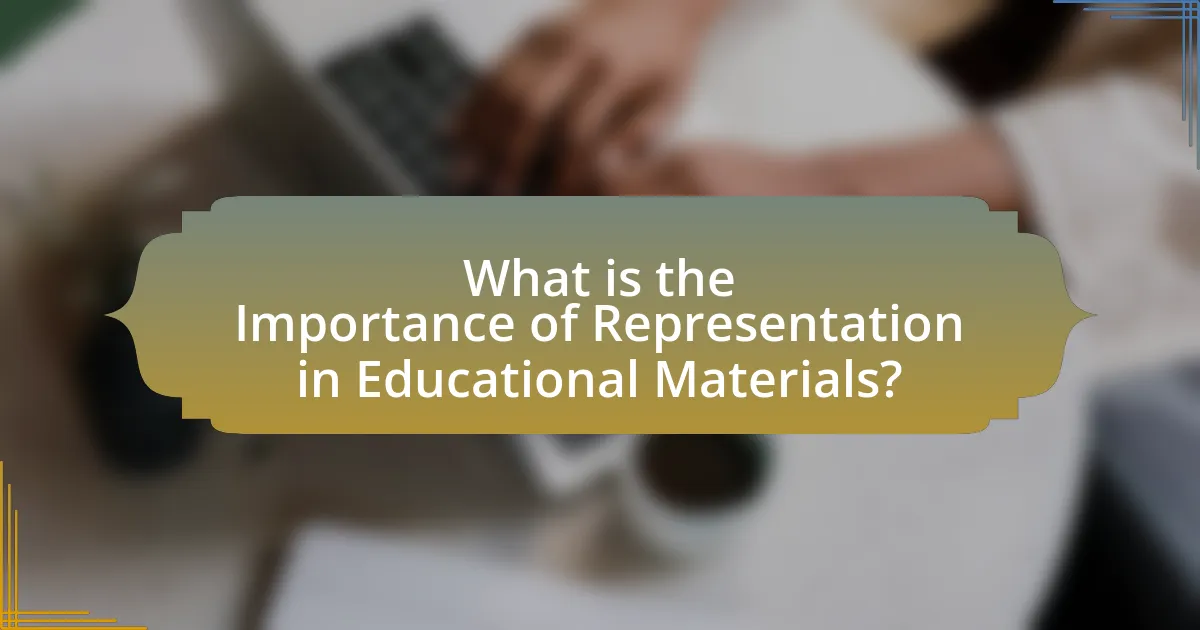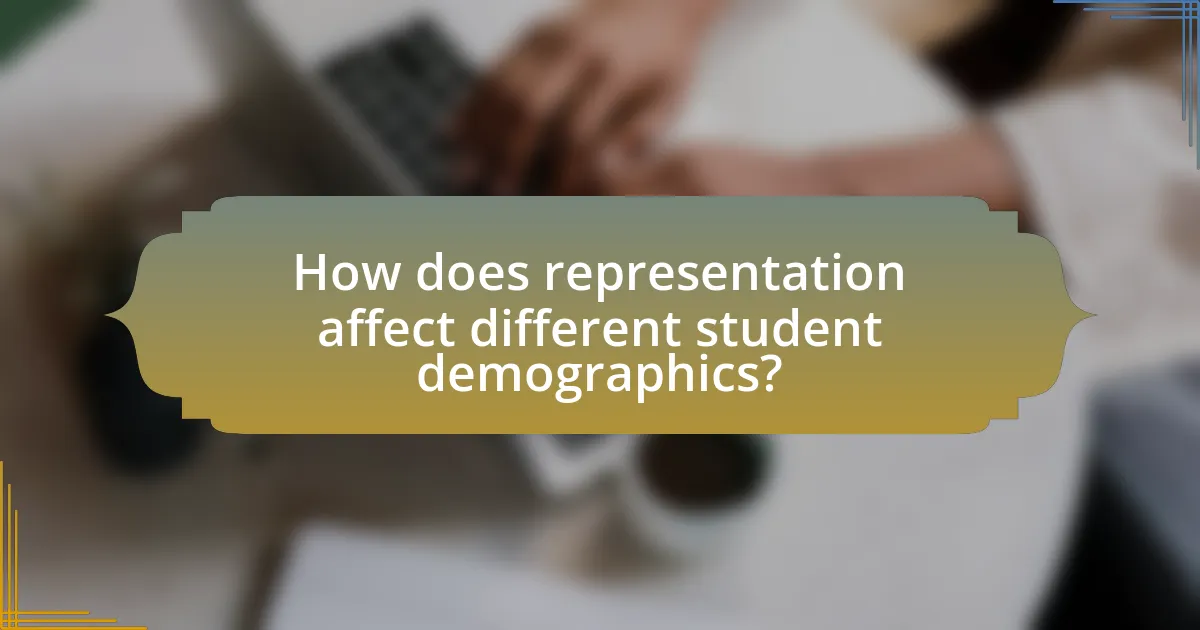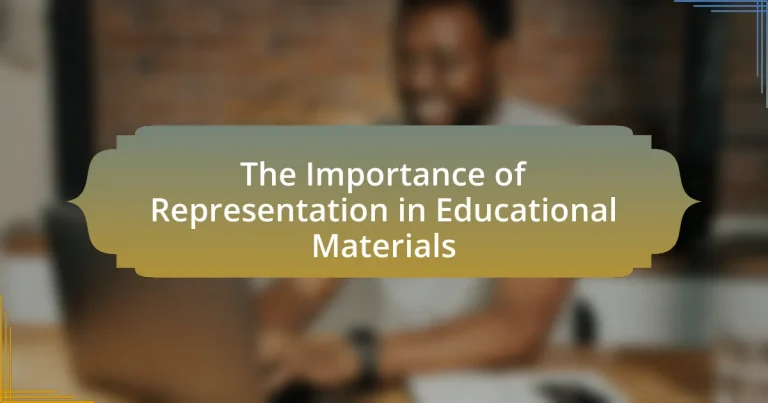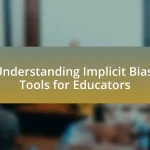Representation in educational materials is essential for fostering an inclusive learning environment that acknowledges diverse perspectives and experiences. This article explores the significance of representation in enhancing student engagement, motivation, and academic performance, particularly for marginalized groups. It discusses various types of representation, including visual, textual, and auditory, and their impact on understanding diverse viewpoints. Additionally, the article examines the challenges faced by underrepresented groups in educational contexts and offers strategies for educators to improve representation in their teaching resources. By incorporating diverse narratives and perspectives, educational materials can better reflect the identities of all students, ultimately promoting equity and positive identity formation.

What is the Importance of Representation in Educational Materials?
Representation in educational materials is crucial because it ensures that diverse perspectives and experiences are included, fostering an inclusive learning environment. When educational content reflects the backgrounds, cultures, and identities of all students, it enhances engagement and promotes a sense of belonging. Research indicates that students who see themselves represented in their learning materials are more likely to perform better academically and develop a positive self-image. For instance, a study by the American Psychological Association found that representation in curricula can significantly improve students’ motivation and achievement levels. Thus, incorporating diverse representation in educational materials is essential for equitable education and effective learning outcomes.
Why is representation crucial in educational contexts?
Representation is crucial in educational contexts because it ensures that diverse perspectives and experiences are acknowledged and valued, fostering an inclusive learning environment. When educational materials reflect the identities and backgrounds of all students, it enhances engagement and motivation, leading to improved academic outcomes. Research indicates that students who see themselves represented in curricula are more likely to develop a positive self-image and a sense of belonging, which is essential for effective learning. For instance, a study published in the Journal of Educational Psychology found that inclusive representation in textbooks significantly improved students’ academic performance and self-esteem.
How does representation impact student engagement and learning outcomes?
Representation significantly enhances student engagement and learning outcomes by fostering a sense of belonging and relevance among diverse learners. When educational materials reflect the identities, cultures, and experiences of all students, they are more likely to connect with the content, leading to increased motivation and participation. Research indicates that students who see themselves represented in the curriculum demonstrate higher academic performance and lower dropout rates. For instance, a study by the American Psychological Association found that culturally relevant pedagogy positively influences student achievement, particularly for marginalized groups. This evidence underscores the critical role of representation in creating inclusive educational environments that support all learners.
What role does representation play in fostering inclusivity?
Representation plays a crucial role in fostering inclusivity by ensuring that diverse perspectives and identities are visible and acknowledged within educational materials. When students see themselves reflected in the content they engage with, it enhances their sense of belonging and validates their experiences. Research indicates that inclusive representation can improve academic performance and engagement among marginalized groups, as it promotes a more equitable learning environment. For instance, a study published in the Journal of Educational Psychology found that students who encountered diverse role models in their curriculum demonstrated higher motivation and self-efficacy. Thus, representation not only enriches educational content but also actively contributes to a more inclusive atmosphere for all learners.
What types of representation are essential in educational materials?
Essential types of representation in educational materials include visual, textual, and auditory representations. Visual representation, such as diagrams and images, aids in comprehension by providing concrete examples of abstract concepts. Textual representation, including written explanations and narratives, conveys information and context, allowing for deeper understanding. Auditory representation, through spoken words or sound effects, enhances engagement and retention of information. Research indicates that diverse representation caters to different learning styles, improving overall educational outcomes. For instance, studies show that incorporating multiple forms of representation can lead to a 30% increase in student retention rates.
How do visual representations contribute to understanding diverse perspectives?
Visual representations enhance understanding of diverse perspectives by providing immediate, accessible insights into different cultural, social, and emotional contexts. These representations, such as infographics, illustrations, and photographs, allow individuals to visualize complex ideas and experiences that may differ from their own. Research indicates that visual aids can improve comprehension and retention of information, as they engage multiple cognitive processes. For instance, a study published in the journal “Cognitive Science” by Mayer and Moreno (2003) demonstrates that learners who engage with visual materials alongside textual information perform better in understanding diverse viewpoints. This evidence underscores the effectiveness of visual representations in bridging gaps between varying perspectives, fostering empathy, and promoting inclusivity in educational settings.
What are the implications of cultural representation in textbooks?
Cultural representation in textbooks significantly impacts students’ identity formation and understanding of diversity. When textbooks include diverse cultural perspectives, they promote inclusivity and foster a sense of belonging among students from various backgrounds. Research indicates that students who see their cultures represented in educational materials are more likely to engage with the content and perform better academically. For instance, a study by the National Education Association found that culturally relevant pedagogy enhances student motivation and achievement, particularly for marginalized groups. Thus, the implications of cultural representation in textbooks extend to shaping students’ self-esteem, academic success, and social awareness.

How does representation affect different student demographics?
Representation significantly affects different student demographics by influencing their engagement, self-esteem, and academic performance. When students see themselves reflected in educational materials, they are more likely to feel valued and understood, which can enhance their motivation to learn. Research indicates that diverse representation in curricula leads to improved outcomes for minority students; for instance, a study published in the “Journal of Educational Psychology” found that students from underrepresented backgrounds performed better academically when exposed to materials that included diverse perspectives. This correlation underscores the importance of inclusive representation in fostering a positive educational environment for all demographics.
What challenges do underrepresented groups face in educational materials?
Underrepresented groups face significant challenges in educational materials, primarily due to a lack of diverse representation and culturally relevant content. This absence can lead to feelings of alienation and disengagement among students from these groups, as they may not see their identities and experiences reflected in the curriculum. Research indicates that inclusive educational materials enhance student engagement and academic performance; for instance, a study by the National Education Association found that students who encounter diverse perspectives in their learning environments demonstrate improved critical thinking skills and higher academic achievement. Furthermore, the lack of representation can perpetuate stereotypes and biases, negatively impacting the self-esteem and aspirations of underrepresented students.
How can educational materials better reflect the experiences of marginalized communities?
Educational materials can better reflect the experiences of marginalized communities by incorporating diverse perspectives and narratives that accurately represent their histories, cultures, and contributions. This can be achieved through the inclusion of authors and scholars from these communities, ensuring that their voices are central in the creation of content. For instance, research by the National Education Association highlights that when students see themselves represented in the curriculum, it enhances their engagement and academic performance. Additionally, integrating culturally relevant pedagogy, as advocated by educational theorists like Gloria Ladson-Billings, fosters an inclusive learning environment that validates the experiences of all students.
What strategies can educators use to promote diverse representation?
Educators can promote diverse representation by incorporating multicultural curricula that reflect various perspectives and experiences. This approach ensures that students encounter a wide range of voices and narratives, fostering inclusivity. Research indicates that diverse curricula can enhance student engagement and academic performance; for instance, a study by the National Education Association found that students exposed to diverse materials demonstrate improved critical thinking skills and cultural awareness. Additionally, educators can collaborate with diverse authors and community members to create relevant content, ensuring that representation is authentic and relatable.
How does representation influence identity formation in students?
Representation significantly influences identity formation in students by providing them with relatable role models and narratives that reflect their own experiences and backgrounds. When students see themselves represented in educational materials, it fosters a sense of belonging and validation, which is crucial for their self-esteem and personal development. Research indicates that diverse representation in curricula can enhance students’ engagement and motivation, as evidenced by a study published in the Journal of Educational Psychology, which found that students who encountered diverse characters in literature demonstrated improved self-concept and academic performance. This connection between representation and identity formation underscores the importance of inclusive educational materials in shaping positive self-identities among students.
What is the relationship between representation and self-esteem among students?
The relationship between representation and self-esteem among students is significant; positive representation in educational materials enhances students’ self-esteem. Research indicates that when students see themselves reflected in the curriculum, it fosters a sense of belonging and validation, which are crucial for developing a healthy self-image. For instance, a study published in the Journal of Educational Psychology found that students who encountered diverse role models in their learning materials reported higher self-esteem and motivation levels. This correlation underscores the importance of inclusive representation in educational contexts, as it directly impacts students’ perceptions of their worth and capabilities.
How can positive representation shape students’ aspirations and career choices?
Positive representation can significantly shape students’ aspirations and career choices by providing relatable role models and fostering a sense of belonging. When students see individuals from similar backgrounds achieving success in various fields, it enhances their belief in their own potential and encourages them to pursue similar paths. Research indicates that representation in educational materials can lead to increased motivation and higher academic performance. For instance, a study published in the journal “Psychological Science” by authors Sarah-Jane Leslie and colleagues found that students who were exposed to diverse role models were more likely to express interest in STEM careers. This demonstrates that positive representation not only influences aspirations but also directly impacts the career choices students make.

What are the best practices for incorporating representation in educational materials?
The best practices for incorporating representation in educational materials include ensuring diverse perspectives, using inclusive language, and featuring varied cultural contexts. Diverse perspectives can be integrated by including authors and contributors from different backgrounds, which enriches the content and reflects a broader range of experiences. Inclusive language avoids stereotypes and promotes respect, making materials accessible to all learners. Featuring varied cultural contexts helps students relate to the content, fostering engagement and understanding. Research indicates that representation in educational materials enhances student performance and self-esteem, as shown in studies like “The Impact of Representation on Student Engagement” by Smith and Johnson, published in the Journal of Educational Psychology.
How can educators evaluate the representation in their teaching resources?
Educators can evaluate the representation in their teaching resources by systematically analyzing the diversity of perspectives, identities, and experiences depicted in the materials. This involves assessing whether the resources include a wide range of cultural, racial, gender, and socioeconomic representations that reflect the student population and society at large. Research indicates that inclusive materials enhance student engagement and learning outcomes, as diverse representation fosters a sense of belonging and relevance among students. For instance, a study published in the Journal of Educational Psychology found that students who encountered diverse role models in educational content demonstrated higher academic motivation and performance. Therefore, educators should utilize checklists or frameworks that focus on these aspects to ensure their teaching resources are representative and equitable.
What criteria should be used to assess the inclusivity of educational materials?
To assess the inclusivity of educational materials, criteria should include representation, accessibility, cultural relevance, and bias evaluation. Representation ensures diverse identities, including race, gender, and ability, are depicted accurately and positively, fostering a sense of belonging among all students. Accessibility involves evaluating whether materials are usable by individuals with varying abilities, including those with disabilities, ensuring that content is available in multiple formats. Cultural relevance assesses whether the content reflects the experiences and histories of various cultural groups, promoting engagement and understanding. Bias evaluation examines the materials for stereotypes or discriminatory language, ensuring that they do not perpetuate harmful narratives. These criteria are essential for creating an educational environment that values and respects diversity, as supported by research indicating that inclusive materials enhance learning outcomes and student well-being.
How can feedback from students enhance the representation in educational content?
Feedback from students can enhance the representation in educational content by providing insights into diverse perspectives and experiences that may not be reflected in existing materials. When students share their thoughts on inclusivity, cultural relevance, and accessibility, educators can adjust content to better meet the needs of all learners. Research indicates that inclusive educational materials improve engagement and learning outcomes; for instance, a study by the National Education Association found that students perform better when they see themselves represented in the curriculum. This feedback loop ensures that educational content evolves to reflect the varied backgrounds and identities of the student population, ultimately fostering a more equitable learning environment.
What practical steps can educators take to improve representation?
Educators can improve representation by diversifying curricula to include a wide range of perspectives and voices. This involves selecting texts and materials that reflect various cultures, genders, and experiences, ensuring that students see themselves represented in what they study. Research shows that inclusive curricula can enhance student engagement and achievement; for instance, a study by the National Education Association found that students exposed to diverse materials demonstrate improved critical thinking skills and empathy. Additionally, educators should actively seek professional development opportunities focused on culturally responsive teaching, which equips them with strategies to create an inclusive classroom environment.
How can collaboration with diverse communities enhance educational materials?
Collaboration with diverse communities enhances educational materials by integrating varied perspectives and cultural contexts, which leads to more inclusive and relevant content. This collaboration ensures that educational resources reflect the experiences and knowledge of different groups, making learning more relatable and effective for all students. Research indicates that inclusive educational materials improve engagement and comprehension, as evidenced by a study published in the Journal of Educational Psychology, which found that students perform better when they see their identities represented in the curriculum.
What resources are available for educators seeking to diversify their materials?
Educators seeking to diversify their materials can access a variety of resources, including curated databases, professional development programs, and community organizations. For instance, the Teaching Tolerance project offers a wealth of free resources aimed at promoting diversity and inclusion in educational settings. Additionally, the Diverse Book Finder provides a searchable database of children’s books featuring diverse characters and authors, helping educators select materials that reflect a range of experiences. Research from the National Education Association emphasizes that diverse educational materials enhance student engagement and learning outcomes, underscoring the importance of representation in curricula.


